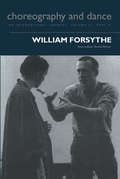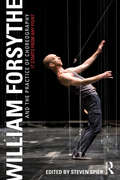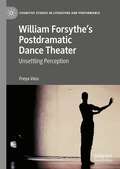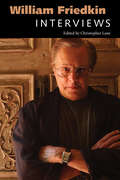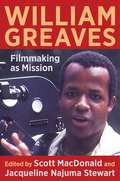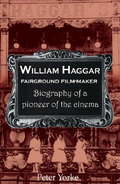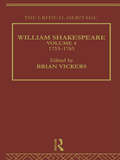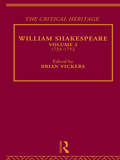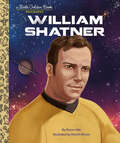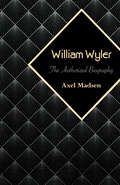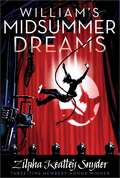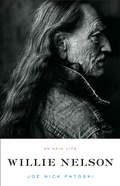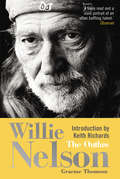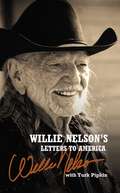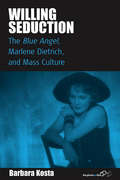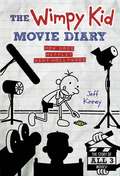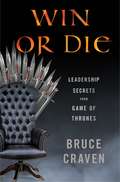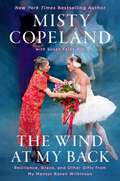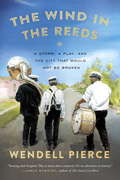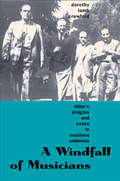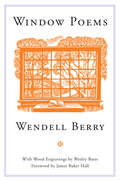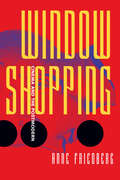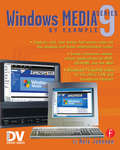- Table View
- List View
William Forsythe: A Tool For The Analytical Dance Eye
by Senta DriverFirst Published in 2000. Routledge is an imprint of Taylor & Francis, an informa company.
William Forsythe and the Practice of Choreography: It Starts From Any Point
by Steven SpierWilliam Forsythe’s reinvigoration of classical ballet during his 20-year tenure at the Ballett Frankfurt saw him lauded as one of the greatest choreographers of the postwar era. His current work with The Forsythe Company has gone even further to challenge and investigate fundamental assumptions about choreography itself. William Forsythe and the Practice of Choreography presents a diverse range of critical writings on his work, with illuminating analysis of his practice from an interdisciplinary perspective. The book also contains insightful working testaments from Forsythe’s collaborators, as well as a contribution from the choreographer himself. With essays covering all aspects of Forsythe’s past and current work, readers are provided with an unparalleled view into the creative world of this visionary artist, as well as a comprehensive resource for students, scholars, and practitioners of ballet and contemporary dance today.
William Forsythe’s Postdramatic Dance Theater: Unsettling Perception (Cognitive Studies in Literature and Performance)
by Freya VassThis book takes choreographer William Forsythe’s choreographic and scenographic processes as a holistic lens through which to view dance as a fundamentally visuo-sonic art form and choreography as a form of perceptual experimentation. In doing so, it reveals how the made worlds within which postdramatic dance is situated influence how choreography is perceived. Resonating with ecological perspectives but also drawing on an extensive range of cognitive research approaches, the volume’s choreo-scenographic perspective emphasizes the importance of considering the expanded scenography of lighting, sound, space, scenic elements, costume, and performer movement when analyzing the sensory and cognitive perception of dance. The volume provides a first book-length cognitive study of both an individual choreographer and the aesthetics of postdramatic theatre. It also satisfies a need for more dedicated scholarship on Forsythe, whose extensive and varied array of groundbreaking ballets and dance theater works for the Ballett Frankfurt (1984-2004), The Forsythe Company (2005-15), and as an independent choreographer have made him a key figure in 20th/21st century dance.
William Friedkin: Interviews (Conversations with Filmmakers Series)
by Christopher LaneAcademy Award–winning director William Friedkin (b. 1935) is best known for his critically and commercially successful films The French Connection and The Exorcist. Unlike other film school–educated filmmakers of the directors’ era, Friedkin got his start as a mailroom clerk at a local TV station and worked his way up to becoming a full-blown Hollywood filmmaker by his thirties. His rapid rise behind the camera from television director to Oscar winner came with self-confidence and unorthodox methods. Known for his gritty and auteurist style, Friedkin’s films tell the story of a changing America upended by crime, hypocrisy, the occult, and amorality. Although his subsequent films achieved varying levels of success, his cultural impact is undeniable. William Friedkin: Interviews collects fifteen articles, interviews, and seminars spanning Friedkin’s career. He discusses early influences, early successes, awards, and current projects. The volume provides coverage of his directorial process, beliefs, and anecdotes from his time serving as the creative force of some of the biggest films of the 1970s and beyond—from his early days in Chicago to his run-ins with Alfred Hitchcock to firing guns on set and witnessing an actual exorcism in Italy. Through previously unpublished and obscure interviews and seminars, the story of William Friedkin’s work and life is woven together into a candid and concise impression for cinephiles, horror junkies, and aspiring filmmakers alike. Readers will gain insight into Friedkin’s genius from his own perspectives and discover the thoughts and processes of a true maverick of American cinema.
William Greaves: Filmmaking as Mission
by Scott MacDonald and Jacqueline Najuma StewartWilliam Greaves is one of the most significant and compelling American filmmakers of the past century. Best known for his experimental film about its own making, Symbiopsychotaxiplasm: Take One, Greaves was an influential independent documentary filmmaker who produced, directed, shot, and edited more than a hundred films on a variety of social issues and on key African American figures ranging from Muhammad Ali to Ralph Bunche to Ida B. Wells. A multitalented artist, his career also included stints as a songwriter, a member of the Actors Studio, and, during the late 1960s, a producer and cohost of Black Journal, the first national television show focused on African American culture and politics.This volume provides the first comprehensive overview of Greaves’s remarkable career. It brings together a wide range of material, including a mix of incisive essays from critics and scholars, Greaves’s own writings, an extensive meta-interview with Greaves, conversations with his wife and collaborator Louise Archambault Greaves and his son David, and a critical dossier on Symbiopsychotaxiplasm. Together, they illuminate Greaves’s mission to use filmmaking as a tool for transforming the ways African Americans were perceived by others and the ways they saw themselves. This landmark book is an essential resource on Greaves’s work and his influence on independent cinema and African-American culture.
William Haggar: Fairground Film Maker
by Peter YorkeBiography of William Haggar, a pioneer of the cinema.Written by Haggar's great-grandson, the book draws on oral reminiscences, unpublished family memoirs and contemporary press reports. It tells the rags-to-riches story of a travelling theatrical who became one of Britain's select band of pioneer film-makers. Containing information on Victorian portable theatres, fairground bioscope shows and Haggar's films, it is a "must" for anyone interested in the popular entertainment of 100 years ago.Contents:- Ten chapters deal with Haggar's life (1851-1925) from his birth at Dedham, Essex, via forty years of travelling with portable theatres and his own Bioscope Exhibition, to respected retirement in Aberdare, South Wales. The last chapter relates the subsequent rediscovery of his films and the recognition of their pioneering quality.- Illustrations include contemporary family portraits, photographs of his huge ornate bioscope sh ow-fronts and stills from his films.- Eight factual appendices provide supporting lists and descriptions of plays and films; and the full texts of particular newspaper articles alluded to in the main narrative.- Notes on sources of information, references and other details.The author, William Haggar's great-grandson Peter Yorke was educated at Queen Elizabeth's Hospital, Bristol, and Pembroke College, Cambridge, graduating in Classics in 1960. Much of his working life was spent representing the University of East Anglia, Norwich, as client to architects, consultants and contractors constructing the then "new university". Retiring in 1996 and moving to Dorset, he has researched his great-grandfather's life and times, travelling throughout England and Wales and to Australia to meet his Haggar relatives to consult their memories for inclusion in this book.
William Haggar: Fairground Film Maker
by Peter YorkeBiography of William Haggar, a pioneer of the cinema.Written by Haggar's great-grandson, the book draws on oral reminiscences, unpublished family memoirs and contemporary press reports. It tells the rags-to-riches story of a travelling theatrical who became one of Britain's select band of pioneer film-makers. Containing information on Victorian portable theatres, fairground bioscope shows and Haggar's films, it is a "must" for anyone interested in the popular entertainment of 100 years ago.Contents:- Ten chapters deal with Haggar's life (1851-1925) from his birth at Dedham, Essex, via forty years of travelling with portable theatres and his own Bioscope Exhibition, to respected retirement in Aberdare, South Wales. The last chapter relates the subsequent rediscovery of his films and the recognition of their pioneering quality.- Illustrations include contemporary family portraits, photographs of his huge ornate bioscope sh ow-fronts and stills from his films.- Eight factual appendices provide supporting lists and descriptions of plays and films; and the full texts of particular newspaper articles alluded to in the main narrative.- Notes on sources of information, references and other details.The author, William Haggar's great-grandson Peter Yorke was educated at Queen Elizabeth's Hospital, Bristol, and Pembroke College, Cambridge, graduating in Classics in 1960. Much of his working life was spent representing the University of East Anglia, Norwich, as client to architects, consultants and contractors constructing the then "new university". Retiring in 1996 and moving to Dorset, he has researched his great-grandfather's life and times, travelling throughout England and Wales and to Australia to meet his Haggar relatives to consult their memories for inclusion in this book.
William Shakespeare: The Critical Heritage Volume 4 1753-1765 (Critical Heritage Ser.)
by Brian VickersFirst published in 1995. Routledge is an imprint of Taylor & Francis, an informa company.
William Shakespeare: The Critical Heritage Volume 3 1733-1752 (Critical Heritage Ser.)
by Brian VickersFirst published in 1995. Routledge is an imprint of Taylor & Francis, an informa company.
William Shatner: A Little Golden Book Biography (Little Golden Book)
by Bruce HaleHelp your little one dream big with a Little Golden Book biography about William Shatner, the actor who explored new worlds on Star Trek. Little Golden Book biographies are the perfect introduction to nonfiction for young readers—as well as fans of all ages!This Little Golden Book about William Shatner--best known as Captain Kirk from Star Trek and the oldest person to travel to space in real life--is an inspiring read-aloud for young children, as well as their Trekkie parents and grandparents.Look for more Little Golden Book biographies: • Betty White • Carol Burnett • Lucille Ball • Harry Belafonte • Julie Andrews • Dwayne Johnson
William Wyler
by Axel MadsenThe authorized biography of the celebrated film director, a giant in his craft, who directed such classics as Ben-Hur, Funny Girl, and Roman Holiday.
William's Midsummer Dreams
by Zilpha Keatley SnyderFrom three-time Newbery Honor author Zilpha Keatley Snyder, "an adventure story with a lot to say about identity, ambition, and character" (Kirkus Reviews).After a year living with Aunt Fiona, William is off to audition for the role of Puck in a summer production of A Midsummer Night's Dream. But getting the part is just the beginning. Now William has to deal with a jealous rival out to sabotage him, a not-so-secret admirer, and the way the Baggetts still haunt him in nightmares. William's summer is filled with acting and costumes and applause, but he still worries sometimes that he and his younger siblings will never be able to shake off the past. But when the Baggetts show up again, William realizes that he is braver than he thought, and that all will turn out okay.
Willie Nelson: An Epic Life
by Joe Nick PatoskiFrom his first performance at age four, Willie Nelson was driven to make music and live life on his own terms. But though he is a songwriter of exceptional depth - "Crazy" was one of his early classics - Willie only found success after abandoning Nashville and moving to Austin, Texas.Red Headed Stranger made country cool to a new generation of fans. Wanted: The Outlaws became the first country album to sell a million copies. And "On the Road Again" became the anthem for Americans on the move. A craggy-faced, pot-smoking philosopher, Willie Nelson is one of America's great iconoclasts and idols.Now Joe Nick Patoski draws on over 100 interviews with Willie and his family, band, and friends to tell Nelson's story, from humble Depression-era roots, to his musical education in Texas honky-tonks and his flirtations with whiskey, women, and weed; from his triumph with #1 hit "Always On My Mind" to his nearly career-ending battles with debt and the IRS; and his ultimate redemption and ascension to American hero
Willie Nelson: The Outlaw
by Graeme ThomsonIn this intimate and engaging biography, Graeme Thomson interviews Nelson himself, his band and those who knew him best en route to discovering the real Willie Nelson. The Outlaw brilliantly describes a complex and compelling man whose life and music reflect something fundamental at the heart of twentieth-century America. Thomson's revealing portrait is a timely reminder of the stature and achievements of a true living legend. Covering everything from dirt poor beginnings in Texas, global fame in the 70s, four marriages, the death of a son and affairs with Amy Irving and Candice Bergen up to his current position as a 73-year-old pot smoking man of the road, Thomson's account emerges as the first detailed, clear-eyed account of Nelson's fascinating life.
Willie Nelson's Letters to America
by Willie NelsonFollowing his bestselling memoir, It&’s a Long Story, Willie Nelson now delivers his most intimate thoughts and stories in Willie Nelson's Letters to America. From his opening letter &“Dear America&” to his &“Dear Willie&” epilogue, Willie digs deep into his heart and soul--and his music catalog--to lift us up in difficult times, and to remind us of the endless promise and continuous obligations of all Americans--to themselves, to one another, and to their nation.In a series of letters straight from the heart, Willie sends his thanks and his thoughts toAmericans past, present, and future,his closest family members, andhis personal heroes, from our founding fathers to the leaders of future generations.Willie&’s letters are rounded out with the moving lyrics to some of his most famous and insightful songs, including &“Let Me Be a Man,&” &“Family Bible,&” &“Summer of Roses,&” &“Me and Paul,&” and &“Yesterday's Wine.&”
Willing Seduction
by Barbara KostaJosef von Sternberg's 1930 film The Blue Angel (Der blaue Engel) is among the best known films of the Weimar Republic (1919-1933). A significant landmark as one of Germany's first major sound films, it is known primarily for launching Marlene Dietrich into Hollywood stardom and for initiating the mythic pairing of the Austrian-born American director von Sternberg with the star performer Dietrich. This fascinating cultural history of The Blue Angel provides a new interpretive framework with which to approach this classic Weimar film and suggests that discourses on mass and high culture are integral to the film's thematic and narrative structure. These discourses surface above all in the relationship between the two main characters, the cabaret entertainer Lola Lola (Marlene Dietrich) and the high school teacher Immanuel Rath (one-time Oscar winner Emil Jannings). In addition to offering insight into some of the major debates that informed the Weimar Republic, this book demonstrates that similar issues continue to shape the contemporary cultural landscape of Germany. Barbara Kosta thus also looks at Dietrich as a contemporary cultural icon and at her symbolic value since German unification and at Lola Lola's various "incarnations."
Willow the Duckling (Dr. KittyCat #4)
by Jane ClarkeFeathers will fly if this feline vet can’t cure a baby duck’s stage fright in this delightful adventure from the author of Daisy the Kitten.We’ll be there in a whisker! Dr. KittyCat is a talented vet—and an adorable cat. She’s ready to rescue whenever help is needed.All the little animals of Thistletown are putting on a show. Dr. KittyCat is on hand to make sure everyone stays safe. When Willow the duckling feels sick just before she’s supposed to go on stage, she’s worried she’ll miss her big moment. Dr. KittyCat must get quacking and figure out what’s wrong!Willow has two-color art inside! Supercute photographs of real animals combine with hand-drawn orange line art for a completely unique look.Praise for Posy the Puppy“Beatrix Potter meets Grey’s Anatomy as a feline medic tends to animals’ scraped ears, hurt ankles, and other bumps and bruises in this series opener.” —Publishers Weekly“Cuddly animals everywhere are lucky to have Dr. KittyCat on call.” —Kirkus Reviews
The Wimpy Kid Movie Diary (Dog Days Revised and Expanded Edition)
by Jeff KinneyIf you’ve ever wondered how a movie gets made, you’re not alone. Author and illustrator Jeff Kinney didn’t know either, but when his bestselling Diary of a Wimpy Kid series was turned into a live-action movie by 20th Century Fox, he learned how books get adapted for the screen in not one but three major motion pictures. Complete with photographs, script pages, storyboard sketches, costume designs, and original art by Jeff Kinney, The Wimpy Kid Movie Diary—now updated to include the new movie Diary of a Wimpy: Dog Days—is the perfect companion to the bestselling series.
Win or Die: Leadership Secrets from Game of Thrones
by Bruce Craven“When it comes to the most-anticipated business books of 2019, Win or Die: Leadership Secrets From Game of Thrones is the one to beat.”—Inc.A guide to leading without losing your head, inspired by the bestselling books and smash television series Game of Thrones. "When you play the game of thrones, you win or you die. There is no middle ground." —Cersei LannisterOne of the great joys of Game of Thrones is strategizing what bold moves you'd make in this bloody, volatile world—from the comfort of your living room. And one of the great terrors of being a leader is knowing your real world can be just as brutal—and offices bring no comfort.Every day you're presented with opportunities and challenges, and must decide which roads to follow, which risks to confront, when to deny an opportunity and when to pursue the call to adventure. And you won't know whether you'll profit or fail while you're in the thick of it. In Win or Die: Leadership Secrets from Game of Thrones, Bruce Craven brilliantly analyzes the journeys of the best and worst leaders in Westeros, so that leaders can create their own narratives of success.Craven considers beloved characters such as Ned Stark, Jon Snow, Daenerys Targaryen, and Tyrion Lannister as they make terrible decisions and fatal mistakes, but also achieve incredible victories and surprising successes, learning and growing along their (often bloody) ways. Readers will learn how to face conflict and build resilience, develop contextual and emotional intelligence, develop their vision, and more.This entertaining and accessible guide will show readers how to turn danger into opportunity, even when dragons threaten.
The Wind at My Back: Resilience, Grace, and Other Gifts from My Mentor, Raven Wilkinson
by Misty CopelandFrom celebrated ballerina and New York Times bestselling author Misty Copeland, a heartfelt memoir about her friendship with trailblazer Raven Wilkinson which captures the importance of mentorship, shared history, and honoring the past to ensure a stronger future.Misty Copeland made history as the first African-American principal ballerina at the American Ballet Theatre. Her talent, passion, and perseverance enabled her to make strides no one had accomplished before. But as she will tell you, achievement never happens in a void. Behind her, supporting her rise was her mentor Raven Wilkinson. Raven had been virtually alone in her quest to breach the all-white ballet world when she fought to be taken seriously as a Black ballerina in the 1950s and 60s. A trailblazer in the world of ballet decades before Misty&’s time, Raven faced overt and casual racism, hostile crowds, and death threats for having the audacity to dance ballet.The Wind at My Back tells the story of two unapologetically Black ballerinas, their friendship, and how they changed each other—and the dance world—forever. Misty Copeland shares her own struggles with racism and exclusion in her pursuit of this dream career and honors the women like Raven who paved the way for her but whose contributions have gone unheralded. She celebrates the connection she made with her mentor, the only teacher who could truly understand the obstacles she faced, beyond the technical or artistic demands.A beautiful and wise memoir of intergenerational friendship and the impressive journeys of two remarkable women, The Wind at My Back captures the importance of mentorship, of shared history, and of respecting the past to ensure a stronger future.
The Wind in the Reeds: A Storm, A Play, and the City That Would Not Be Broken
by Wendell Pierce Rod DreherFrom acclaimed actor and producer Wendell Pierce, an insightful and poignant portrait of family, New Orleans and the transforming power of art. <P><P> On the morning of August 29, 2005, Hurricane Katrina barreled into New Orleans, devastating many of the city's neighborhoods, including Pontchartrain Park, the home of Wendell Pierce's family and the first African American middle-class subdivision in New Orleans. <P>The hurricane breached many of the city's levees, and the resulting flooding submerged Pontchartrain Park under as much as 20 feet of water. Katrina left New Orleans later that day, but for the next three days the water kept relentlessly gushing into the city, plunging eighty percent of New Orleans under water. Nearly 1,500 people were killed. Half the houses in the city had four feet of water in them--or more. There was no electricity or clean water in the city; looting and the breakdown of civil order soon followed. Tens of thousands of New Orleanians were stranded in the city, with no way out; many more evacuees were displaced, with no way back in. Pierce and his family were some of the lucky ones: They survived and were able to ride out the storm at a relative's house 70 miles away. When they were finally allowed to return, they found their family home in tatters, their neighborhood decimated. Heartbroken but resilient, Pierce vowed to help rebuild, and not just his family's home, but all of Pontchartrain Park. In this powerful and redemptive narrative, Pierce brings together the stories of his family, his city, and his history, why they are all worth saving and the critical importance art played in reuniting and revitalizing this unique American city.From the Hardcover edition.
A Windfall of Musicians
by Dorothy Lamb CrawfordThis book is the first to examine the brilliant gathering of composers, conductors, and other musicians who fled Nazi Germany and arrived in the Los Angeles area. Musicologist Dorothy Lamb Crawford looks closely at the lives, creative work, and influence of sixteen performers, fourteen composers, and one opera stage director, who joined this immense migration beginning in the 1930s. Some in this group were famous when they fled Europe, others would gain recognition in the young musical culture of Los Angeles, and still others struggled to establish themselves in an environment often resistant to musical innovation. Emphasizing individual voices, Crawford presents short portraits of Igor Stravinsky, Arnold Schoenberg, and the other musicians while also considering their influence as a group--in the film industry, in music institutions in and around Los Angeles, and as teachers who trained the next generation. The book reveals a uniquely vibrant era when Southern California became a hub of unprecedented musical talent.
Window Poems
by Wendell BerryComposed while Wendell Berry looked out the multipaned window of his writing studio, this early sequence of poems contemplates Berry’s personal life as much as it ponders the seasons he witnessed through the window. First designed and printed on a Washington hand press by Bob Barris at the Press on Scroll Road, Window Poems includes elegant wood engravings by Wesley Bates that complement the reflective and meditative beauty of Berry’s poems.
Window Shopping: Cinema and the Postmodern
by Anne FriedbergDeparting from those who define postmodernism in film merely as a visual style or set of narrative conventions, Anne Friedberg develops the first sustained account of the cinema's role in postmodern culture. She explores the ways in which nineteenth-century visual experiences—photography, urban strolling, panorama and diorama entertainments—anticipate contemporary pleasures provided by cinema, video, shopping malls, and emerging "virtual reality" technologies.Comparing the visual practices of shopping, tourism, and film-viewing, Friedberg identifies the experience of "virtual" mobility through time and space as a key determinant of postmodern cultural identity. Evaluating the theories of Jameson, Lyotard, Baudrillard, and others, she adds critical insights about the role of gender and gender mobility in the configurations of consumer culture.A strikingly original work, Window Shopping challenges many of the existing assumptions about what exactly postmodern is. This book marks the emergence of a compelling new voice in the study of contemporary culture.
Windows Media 9 Series by Example
by Nels JohnsonVideographers can harness the potential that WM9 offers to deliver high-quality video and multimedia via DVD and over the Internet. Illustrated examples and tutorials demonstrate the basic functionality of WM9 as well as the options available to advanced users who wish to design new applications with the software development kit. Professional videographers will find this book to be a practical way to learn how to set up players, encoders, and servers and how to capture and compress video so they can use WM9 with the applications they use every day, including Powerpoint, Premiere, After Effects, and Avid.
